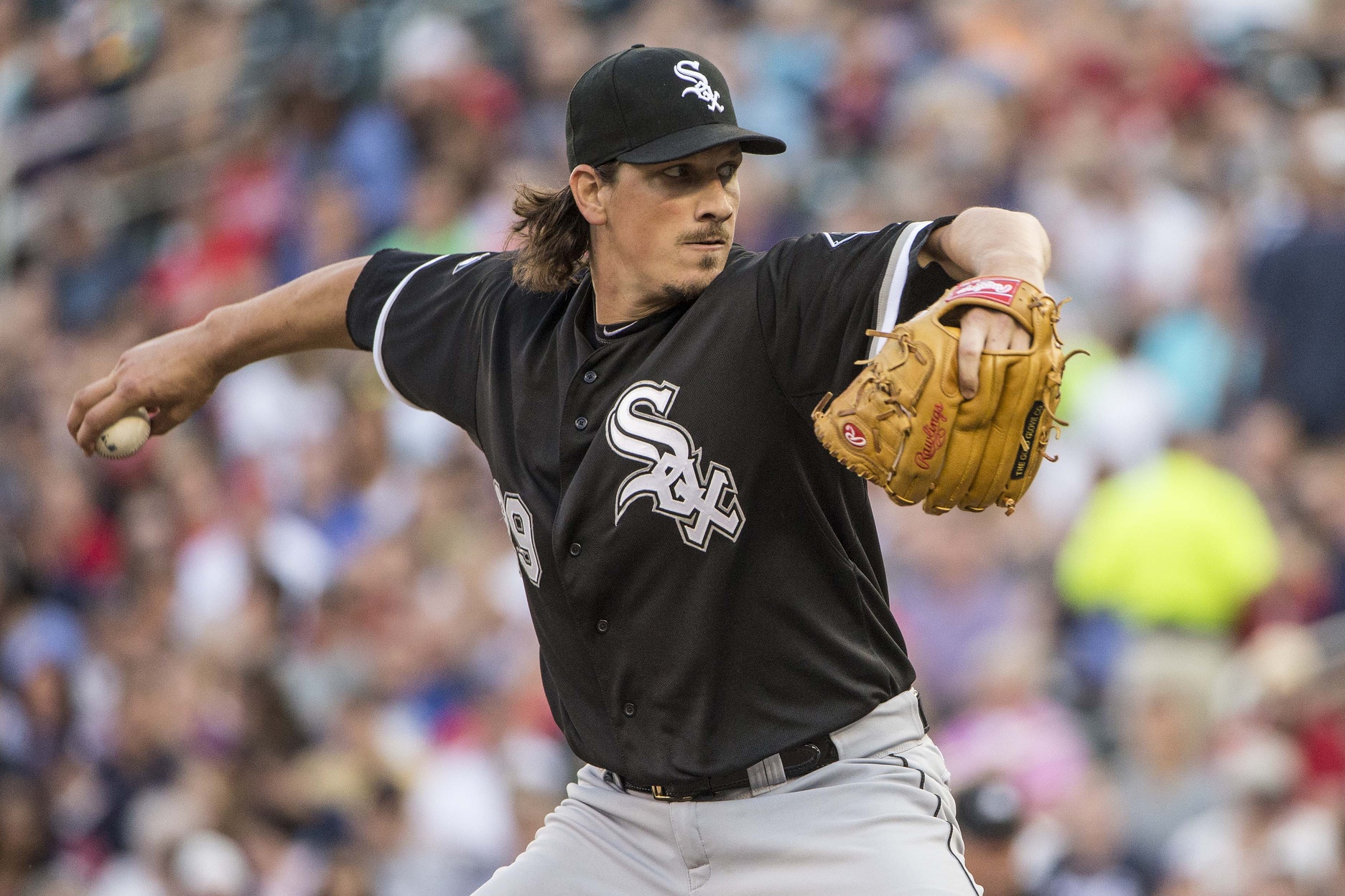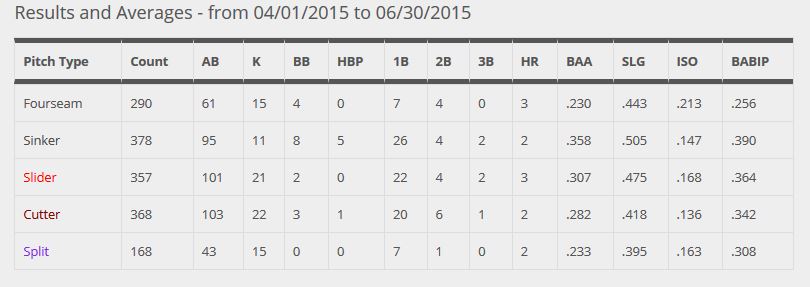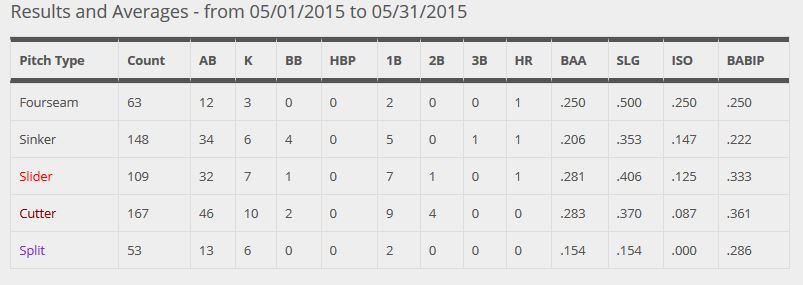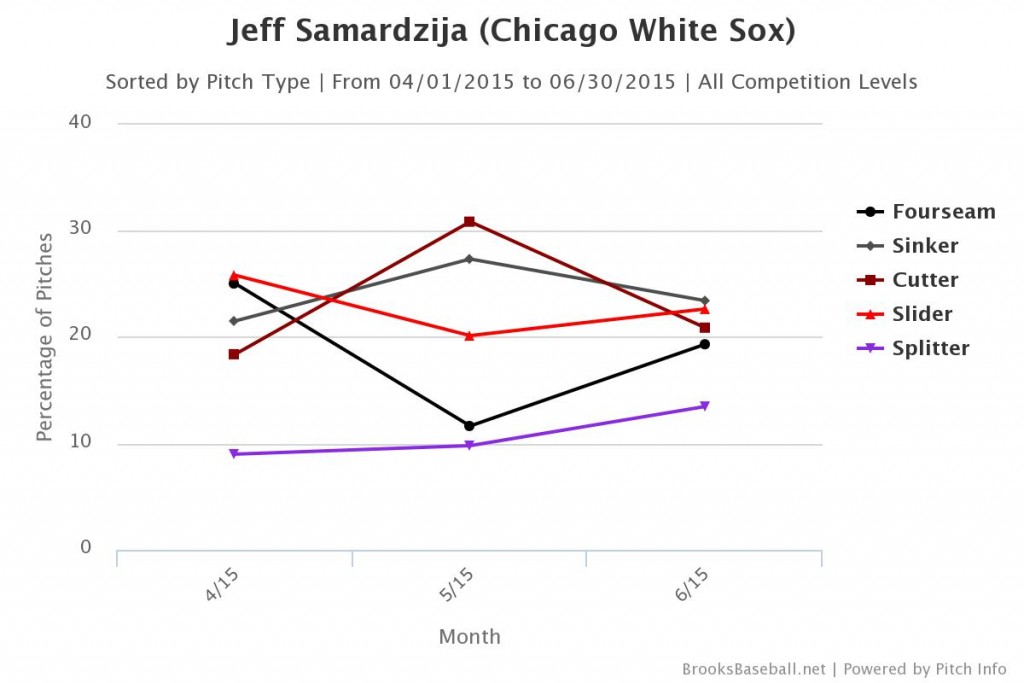Last season, the Cubs reportedly offered Jeff Samardzija a contract extension worth 5 years, $85 million to lock him up long term. It was thought then, by many, that Samardzija was on the verge of becoming an ace and that the Cubs couldn’t let go of the opportunity to get their homegrown guy locked up. But, in a move that suggested he was betting on himself, Samardzija rejected that offer and was traded to Oakland within a few weeks.
Many have speculated that the constant trade rumors rubbed him the wrong way and he soured on the Cubs, or that he didn’t want to be part of a rebuild anymore. The prevailing thought that makes the most sense, to me, is that Samardzija simply wanted more money. And why not? Homer Bailey had signed a 6 year, $105 million extension with the Reds and Samardzija had every right to believe he deserved the same kind of deal. And the Cubs had every right not to offer it to him more than a year away from free agency.
So now here we are. Samardzija finished out a strong season with the A’s and moved back to Chicago in the offseason as part of the White Sox attempt to transform a 73-win team into a contender. Things haven’t gone the way the Sox or Samardzija had hoped, and at this rate he’s probably praying that someone will offer as much this winter as the Cubs did last year.
Through 16 starts this season, Samardzija has a 4.54 ERA, 3.62 FIP, and a 4.26 DRA (which is designed to measure what a pitcher “deserves”). He’s thrown 108 2/3 innings and faced a league-high 464 batters, while allowing a league-high 123 hits. He’s walking a career-low 1.7 batters per nine innings while also striking out a career-low 7.3. Just looking at some of Samardzija’s peripheral numbers makes it hard to put your finger on what’s turned him from “potential ace” to “fringe fourth starter.”
Fortunately, I have resources such as what Sahadev Sharma wrote for the Baseball Prospectus back in May. Sahadev correctly points out a dramatic rise in the usage of the cutter for Samardzija this year, and the effect that it’s had on the results:
Early on this year, Samardzija has relied on his cutter more than ever before. Results-wise, it’s been one of his better pitches, as it’s the only offering that opponents don’t have an ISO above .200 against (.063) and it’s his best groundball-inducing pitch at 42.1 percent of balls in play.
All of this was true at the time that it was written, but a few things have changed and it’s important to note that. While the cutter has been a successful pitch for him this season, the rest of his numbers have stabilized a bit. Here is a breakdown of the results on Samardzija’s pitches in 2015.
I thought it was odd that his cutter has been an effective pitch for him now, after a full career of being primarily a fastball/sinker/slider pitcher. To me, his fastball and splitter (despite it not being used as heavily) have been consistently his best pitches this season, allowing the lowest batting averages, slugging, and BABIP’s while posting the best K rates.
That’s not to say that the cutter hasn’t been a quality pitch for Samardzija, especially during the month of May. Here are the results on his pitches when narrowed down to just May.
Here we see a lowered slugging percentage and a minuscule ISO on the cutter. The splitter has the best stats attached to it, but it’s hardly used at all during this span of five starts. To place this in better context, we need to be able to see the frequency with which he was throwing his pitches during this time.
While the sinker, slider, and splitter follow somewhat normal patterns, the fastball and the cutter essentially flip in the middle. The cutter usage shoots straight upward before sloping back down to almost the same level a month later. The fastball is almost non-existent in May, but is back to being used almost as frequently as the cutter by June.
So what does it all mean, man? I think the problem for Samardzija is that he pitches for the White Sox. Statistically, his fastball has brought a higher K rate (23 percent) than his cutter (20.7 percent). His BABIP is much higher on his cutter (.342) than his fastball (.256), as well. That means he’s relying on the team behind him to make plays much more often.
Again, something important from Sahadev’s piece stands out to me:
Part of what contributed to Samardzija’s strong season last year was his ability to induce weak contact early in the game, allowing him to lower his pitch count and go deeper into games. Then, Samardzija would rack up the strikeouts later in the game if and when they were needed—his 37.5 percent strikeout rate in the seventh inning last season was easily his highest by inning.
In defensive metrics, such as defensive efficiency and park-adjusted defensive efficiency, the Sox are dead last in baseball. In the case of PADE, they’re significantly lower (-5.29) than the next lowest team (-3.30). Outside of Gordon Beckham, who only plays part-time, and Adam LaRoche, who has spent most of his time as the designated hitter to appease Jose Abreu, there is nary a quality fielder in the lineup on a regular basis.
Consequently, Samardzija’s propensity for trying to induce contact early in the game to allow him to overpower batters later has worked against him this season. Let me explain this with some tables; first, look at the change in his K/9 as the game moves along.
| Innings | K/9 innings |
| First through Third | 5.4 |
| Fourth through Sixth | 8.6 |
| Seventh through Ninth | 9.2 |
Based on what we know about Samardzija, this shouldn’t be surprising at all. But now look at a breakdown of his results by inning.
| Inning | Hits Allowed | Walks | ERA |
| First | 31 | 6 | 9.56 |
| Second | 13 | 4 | 4.50 |
| Third | 17 | 3 | 3.38 |
| Fourth | 18 | 3 | 4.50 |
| Fifth | 15 | 0 | 2.25 |
| Sixth | 13 | 2 | 3.21 |
| Seventh | 11 | 1 | 1.64 |
All of this, to me, says a lot about why Samardzija could be a serious dark-horse candidate for the Cubs to re-acquire. The Cubs are in the middle of the pack defensively, based on the same defensive metrics I used before, coming in at 16th in all of baseball.
Samardzija could also benefit from enhanced pitch framing, as both Miguel Montero and David Ross are in the top 10 in baseball in this category. Tyler Flowers actually ranks higher than both, but Geovany Soto has caught 15 of Samardzija’s 16 starts and ranks just 27th on the list.
Considering that Samardzija is on a last-place team with no hope for the playoffs and is just months away from free agency, the White Sox would be wise to see if they can get anything at all for him before the trade deadline. As far as available starting pitchers, Samardzija might be one of the cheapest rentals. This move has the Cubs front office written all over it, and could be mutually beneficial.
The Cubs get a quality starter that they’re familiar with, the Sox get a Dan Vogelbach or two, and Samardzija gets a chance to restore his market value.
Lead photo courtesy of Jesse Johnson-USA TODAY Sports




I would absolutely love for Cubs to bring Shark back. I always interpreted his desire to leave a bet on himself to land a bigger contract than Cubs offered as well. The fan in me would love to see him get a chance to be apart of the winning, after all the lousy teams he played for. Plus they type of competitor he was on the mound and how fun his outings were to watch, really makes me hope he’s back in a Cubs uniform soon.
I would doubt he ends up back in a Cubs uniform next year, but they are probably going to have to take a look at it as a trade possibility this year. Unless, of course, a more longterm solution presents itself. Thanks for reading!
I have a feeling that Shark wants to resign with the Sox, since that’s “his team” and he might not get the money he once expected.
But I’m also very much for acquiring him at the deadline, if the price is right. I have NO idea what that package would look like, but I probably wouldn’t give up Baez (who is at the nadir of his trade value). The Cubs’ D is better than the Sox, so I would expect SOME improvement in runs allowed metrics. He’s probably my favorite pitcher on the market right now.
I agree he probably has an interest in resigning with the Sox, but I doubt they’re willing to give out the deal he wants. The Sox made an exception to their “no 5 year deals” rule for Danks, and we all saw how that worked out.
Either way, I think they end up moving him. They need to rebuild and they know it. If they can get Vogelbach, Villanueva, and a lower level prospect, shouldn’t they do it? They still have every opportunity to make an offer to him in the offseason, and if he really wants to be there he can sign.
I would do that deal in a heartbeat, since those guys’ only value is as trade chips in a mid-to-upper tier deal like this. Vogs and Villanueva aren’t going to be pieces in a Hamels deal or any other blockbuster, should they be looking for one.
The only wrinkle is that, if they land Shark, pursuing a contract with him would likely prohibit the pursuit of other FA pitchers. Not that having those options is a bad thing.
I presume it’s too early, but are there rumors about what Shark would be looking for in an extension/new deal? Feels like national media’s perception of him has dropped a lot from where it was when he left the Cubs. Has his leverage fallen as well? Or do front offices still think they can get him back to level of performance where he looked like a potential #1 or #2 starter?
By the way, great piece Ryan and thanks for interacting with us in the peanut gallery.
I am not plugged in enough to know what the inside perception is of him, but I figure if I can put this piece together and read in between the lines on his struggles this year, I assume most in baseball have as well. So I would guess he still has a decent amount of value.
That said, I think he’d be lucky to get the same offer the Cubs gave him last year, which was 5 years/$85 million. But a lot of stuff can change, and GM’s routinely surprise us in free agency.
And thank YOU for reading and commenting! I love to interact with intelligent commenters.